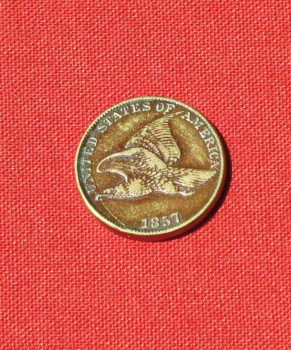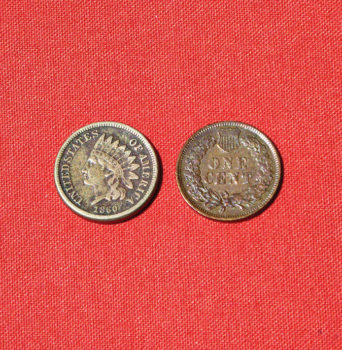
 Ken Marich
Ken Marich
The Indian Penny is an important change to our American coinage as it signaled the end of the large cent era. By 1857, the cost of making copper cents rose to a level that a more cost-effective coin had to be made. Large cents (1793-1857) were made of copper; they were the size of a quarter, weighed 11 grams each and had become unpopular. The new proposed cents (1856-1909) would be made of alloy of copper (88%) and nickel (12%) and would weigh only 4.7 grams. The Mint Director, James Snowden, asked the Chief Engraver, James B. Longacre, to redesign the one cent coin to be smaller and thus the first coin in the Indian series came into being and is known as the Flying Eagle cent (1856-1858). In 1856 a pattern coin was minted to show Congress how the new cent would look. Between 2000-3000 coins were made for sale to collectors. These coins are rare and now range in price from $6000 to $20,000 each. Over 40 million Flying Eagle cents were minted in 1857-1858 and they became very popular and many Flying Eagle cents were hoarded. These two dates currently range in price from $30 to $400 depending on condition.
In 1858 the Mint Director asked Longacre to redesign the one cent coin. Of the various sketches, Snowden opted for the head of an Indian with a feather headdress on the obverse and a simple wreath on the reverse. An interesting fact is the profile of the Indian head is really Caucasian and thought to be the profile of Longacre’s daughter Sarah. But he did not have a daughter in 1858 and admitted the profile was actually from a Greek statue of Venus. Since the introduction of the Indian Head penny, it has undergone several varieties. In 1859 the penny was made of copper-nickel with a laurel wreath on the reverse (36M minted). From 1860-1864, the reverse was changed to an oak wreath with a shield (>120M minted). During the Civil War almost all gold, silver and copper coins disappeared from circulation. Private “Merchant Tokens” began to appear to fill the void of missing cent coins. With the passage of the Act of 1864, the government issued the new bronze Indian pennies (95% copper, 5% tin and magnesium) and made merchant tokens illegal. The bronze Indian pennies were minted from 1864 to 1909 when it was replaced by the Lincoln penny. Collecting Indian and Lincoln pennies are very popular and second only to Morgan dollars. Start an Indian penny collection as most of the coins are affordable, especially from 1879-1909.
The SaddleBrooke Coin Club meets the second Thursday of each month in the Sonoran Room in the MountainView Clubhouse from 7:00 to 9:00 p.m. Our next meeting is Thursday, September 8. For more information contact Ken at 520-825-1709 or kenwm77@gmail.com.
